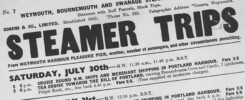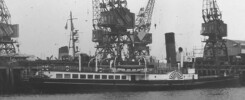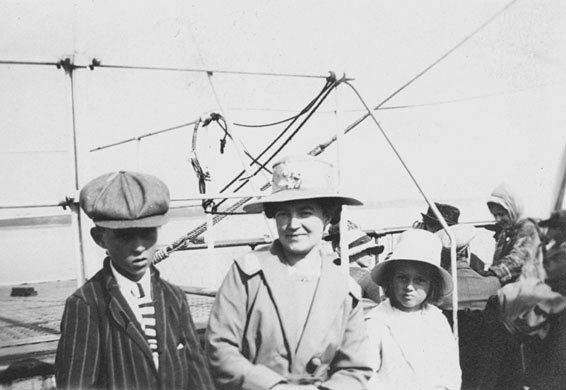
Kingswear Castle season ticket holder and retired P & O ferry captain, Mike Ledger, has come across these fascinating pictures taken by, and of, his family on paddle steamers at Bournemouth in 1920, the first year after the Great War that steamer services were resumed from that resort. The lady in the centre is his grandmother, Fanny Bellamy, the little girl on her left his mother, Joan, and the little boy on her right, his uncle Eric, who, twenty years later, as Sub Lt Eric Bellamy RNVR, took HMS Thrify to Dunkirk as described in the July 2010 Pictures of the Month here.
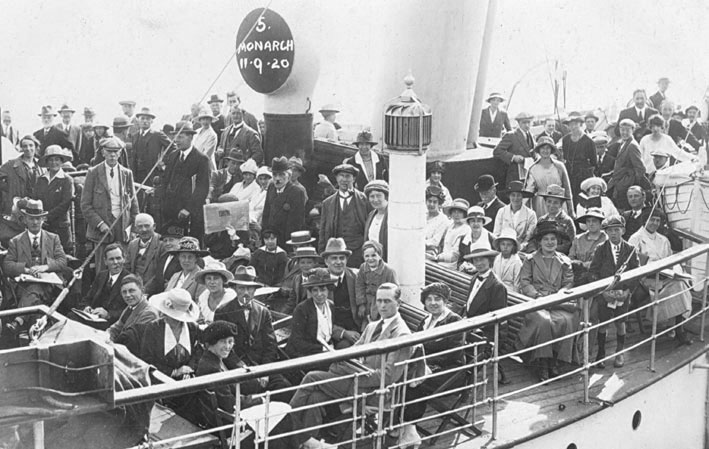
The family were aboard Cosens’ Monarch on 11th September 1920 and are in this shot with Mrs Bellamy sitting on a seat between the ventilator and the lifeboat on the right , with Eric, in his striped tie, on her left and Joan on her right. Mike’s auntie Winnie is behind and between his grandmother and little Eric.
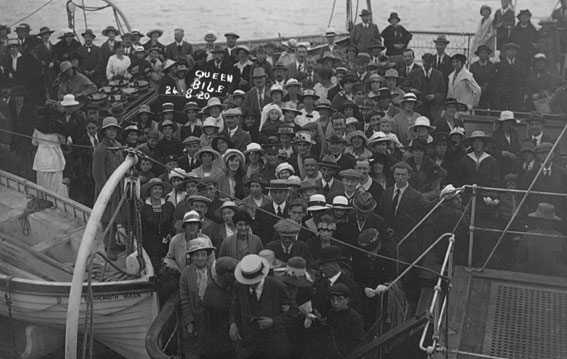
On 24th August 1920 they were aboard Red Funnel’s Bournemouth Queen. If you look closely you can see them just to the right of the caption on the picture with little Joan being lifted up by her mother.
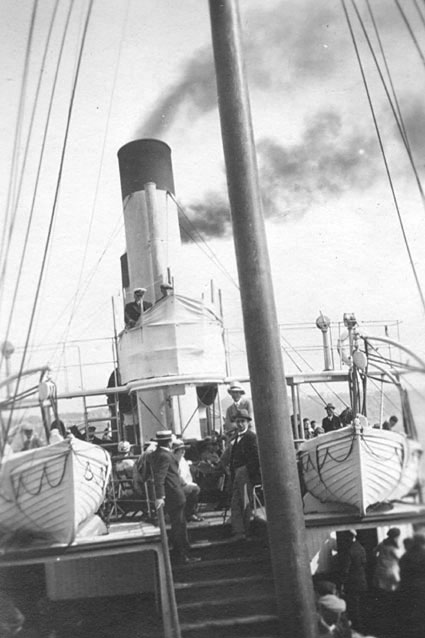
Amongst these pictures are some fascinating close up shots like this one of the Monarch’s bridge, with the bearded Capt H J Hardy on the left. He joined Cosens in 1881 as a seaman but soon worked his way up to become mate and master. He commanded the Albert Victor (1892 – 1901), Victoria (1902 – 1907), Monarch (1908 – 1914), Empress (1919) and the Monarch once again in 1920. After retiring he continued to do occasional reliefs and died in 1930. With the Emperor of India still not re-commissioned after the Great War, the Monarch was Bournemouth’s long distance steamer in 1920.
The bridges were pretty spartan affairs with quite low rails and only a small piece of canvas, often around only part of the rails, to tuck behind and deflect a bit of the wind and rain when the weather was inclement. Nor was there much kit. There was a wheel with a helm indicator on its stand, a binnacle with the compass, engine room telegraphs and, on some paddlers like Monarch, docking telegraphs, a voice pipe to the engine room, a wire to pull the whistle, a box for the binoculars, notebook and almanac and that’s it mate, not even a chart table.
Doubtless the paddlers carried charts stowed away somewhere in the captains’ cabins for use in an emergency but the masters, who all had local pilotage certificates, were expected to know the charts from memory and to be able to come up with any courses and distances, making due allowance for wind and tide, anywhere in their areas in their heads.
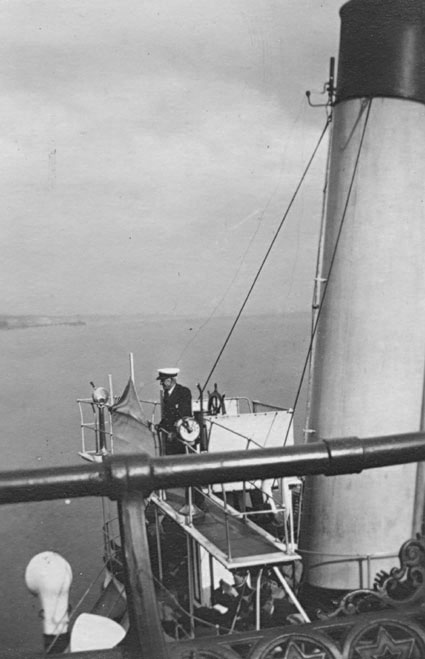
Capt W C “Billy” Read on the bridge of the Alexandra which, in 1920, was mainly on the Bournemouth to Swanage service. He joined Cosens in 1895 and sailed as master of Queen, (1900 – 1910), Helper (1911 -1914), Alexandra (1915 – ?- 1920) and Emperor of India (1921 – 1935) after which he retired.
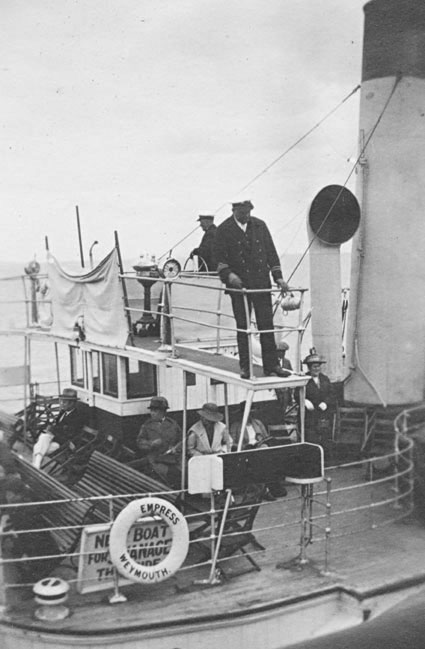
Capt H A Garnett on the bridge of the Empress which, in 1920, was based at Weymouth but visited Bournemouth during each week taking extra sailings on the Swanage service whilst there. Capt Garnett was master of the Albert Victor (1912 – 1920), Queen (at times in 1918-1919), Empress (1920) and Monarch (1921 – 1932). He was taken ill in the winter of 1932/33 and died just as the 1933 season was opening.
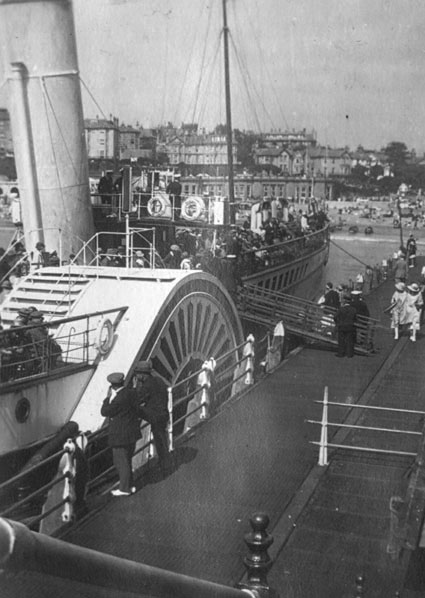
The largest, fastest and most commodious steamer to serve Bournemouth from her arrival in 1900 right up to the Second World War was Red Funnel’s Balmoral. Always taking the long distance sailings, most particularly from Southampton and Bournemouth across the Channel to Cherbourg, she was commanded by Capt A Goldsmith for almost her entire excursion career. He joined the ship as her master in 1906 and remained with her until he retired at the end of the 1938 season.
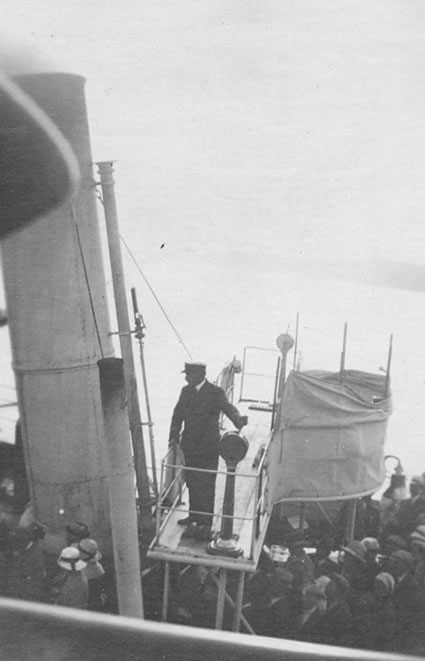
The Princess Helena ran Red Funnel’s Bournemouth to Swanage service from 1911 up to the Great War and returned to the route for just one more season in 1920. I don’t know who her captain is here. Can anyone out there help me?
In the foreground of this picture, note the chimney coming up from the coal-fired galley range located in Princess Helena’s forward starboard sponson.
All of these paddle steamer captains were superb seaman and ship handlers, safely navigating and berthing their charges in often difficult waters with complicated tidal patterns without any of the modern paraphenalia now deemed to be so essential for ship safety such as radios, radar, chart plotters, echo sounders, AIS and paper based Safety Management Systems.
Doubtless the paddlers carried a lead line to feel their way along if it was foggy and a trailing log to record the distance travelled on long, particularly cross channel, sailings. And the captains would also have had a sextant which they could have used for getting the distance off headlands etc. But somehow, expert captains like these, who sailed backwards and forwards, in and out and up and down coasts, estuaries and rivers, day in, day out, developed a sort of sixth sense for knowing just where they were and where they were going without any general need of recourse to kit other than that most useful, and sometimes in today’s modern world under-rated, maritime instrument, the human eyeball.

With her love of trips on paddle steamers, Fanny Bellamy must have had a little bit of the sea in her veins. So it is not altogether surprising that both her son Eric and her grandson, Mike Ledger, went to sea. Here Mike is at the modern day equivalent of the old paddle steamer captains’ telegraphs, bringing his last command, Pride of Ailsa, (ex Pride of Sandwich, ex Free Enterprise VI) into Cairnryan on his last day before retiring in 1994, seventy four years after his grandmother and family had enjoyed their trips on the paddle steamers at Bournemouth.
Kingswear Castle returned to service in 2023 after the first part of a major rebuild which is designed to set her up for the next 25 years running on the River Dart. The Paddle Steamer Kingswear Castle Trust is now fund raising for the second phase of the rebuild. You can read more about the rebuilds and how you can help if you can here.
John Megoran

